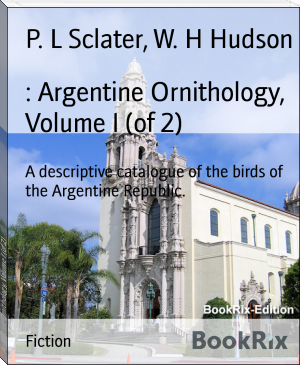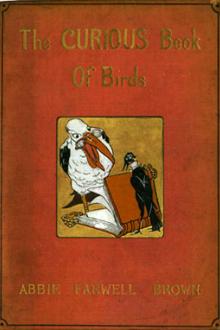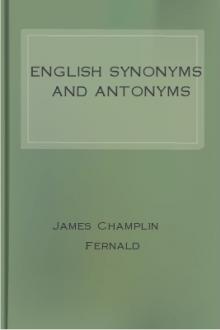: Argentine Ornithology, Volume I (of 2), P. L Sclater, W. H Hudson [best authors to read txt] 📗

- Author: P. L Sclater, W. H Hudson
Book online «: Argentine Ornithology, Volume I (of 2), P. L Sclater, W. H Hudson [best authors to read txt] 📗». Author P. L Sclater, W. H Hudson
rushes die and drop the nest remains securely fastened to them, and in
winter affords a safe and comfortable retreat to the small reed-frogs,
of which sometimes as many as three or four are found living in one
nest. The interior is very thickly lined with feathers; the eggs are
three, pear-shaped, and a bright, beautiful blue colour, sometimes with
a slight greenish tinge.
The bird is so abundant in extensive marshes that I have on several
occasions, during a day's ramble, found as many as forty or fifty nests,
sometimes a dozen or more being placed close together, but I have never
taken more than three eggs from one nest. I mention this because I have
seen it stated that four or five eggs are sometimes found.
I trust that no reader of this sketch imagines that I robbed all the
eggs contained in so many nests. I did nothing so barbarous, although
it is perhaps "prattling out of fashion" to say so; but with the
destructive, useless egg-collecting passion I have no sympathy. By
bending the pliant rushes downwards the eggs can be made to roll out
into the hand; and all those which I thus took out to count were, I am
glad to say, put back in their wonderful cradles. I had a special object
in examining so many nests. A gaucho boy once brought me a nest which
had a small circular _stopper_, made of the same texture as the body of
the nest, attached to the aperture at the _side_, and when swung round
into it fitting it as perfectly as the lid of the trap-door spider fits
the burrow. I have no doubt that it was used to close the nest when the
bird was away, perhaps to prevent the intrusion of reed-frogs or of
other small birds; but I have never found another nest like it, nor have
I heard of one being found by any one else; and that one nest, with its
perfectly-fitting stopper, has been a puzzle to my mind ever since I
saw it.
LEPTASTHENURA ÆGITHALOIDES (Kittl.).
(TIT-LIKE SPINE-TAIL.)
+Synallaxis ægithaloides+, _Burm. La-Plata Reise_, ii. p. 469
(Mendoza); _Hudson, P. Z. S._ 1872, p. 544 (Rio Negro).
+Leptasthenura ægithaloides+, _Scl. et Salv. P. Z. S._ 1869, p.
632 (Buenos Ayres); _iid. Nomencl._ p. 63; _Durnford, Ibis_,
1877, p. 180 (Buenos Ayres), et 1878, p. 396 (Centr. Patagonia);
_Gibson, Ibis_, 1880, p. 30 (Buenos Ayres); _White, P. Z. S._
1882, p. 611 (Catamarca); _Barrows, Bull. Nutt. Orn. Cl._ viii.
206 (Entrerios).
_Description._--Above pale earthy brown; crown black, striped with
clear brown; lores, sides of head, and throat white, with minute
black spots; wings blackish, the edges of the outer webs of the
primaries and the basal part of the secondaries light rufescent
brown; tail black, lateral rectrices tipped and margined with pale
grey; beneath pale grey, throat white; bill and feet horn-colour:
whole length 6·2 inches, wing 2·4, tail 3·5. _Female_ similar.
_Hab._ Chili, Argentina, and Patagonia.
This is a restless little bird, seen singly or in parties of three or
four. In manner and appearance it resembles the Long-tailed Titmouse
(_Parus_), as it diligently searches for small insects in the trees and
bushes, frequently hanging head downwards to explore the under surface
of a leaf or twig, and while thus engaged continually uttering a little
sharp querulous note. They are not migratory, but in winter seem to
wander about from place to place a great deal; and in Patagonia, in the
cold season, I have frequently seen them uniting in flocks of thirty or
forty individuals, and associating with numbers of Spine-tails of other
species, chiefly with _Synallaxis sordida_, and all together advancing
through the thicket, carefully exploring every bush in their way.
D'Orbigny says that it makes a nest of rootlets and moss in a bush; but
where I have observed this bird it invariably breeds in a hole in a
tree, or in the nest of some other bird, often in the clay structure of
the Oven-bird. But in Patagonia, where the Oven-bird is not known, this
Spine-tail almost always selects the nest of the _Synallaxis sordida_.
It carries in a great deal of soft material--soft grass, wool, and
feathers--to reline the cavity, and lays five or six, white, pointed
eggs.
LEPTASTHENURA FULIGINICEPS (d'Orb. et Lafr.).
(BROWN-CRESTED SPINE-TAIL.)
+Leptasthenura fuliginiceps+, _Scl. et Salv. Nomencl._ p. 63; _White,
Z. S._ 1882, p. 611 (Catamarca). +Synallaxis fuliginiceps+,_Burm. La-Plata Reise_, ii. p. 469.
_Description._--Above pale earthy brown; forehead and slightly
crested crown rufous brown; wings blackish, edges of outer webs of
all the wing-feathers and basal part of the secondaries chestnut;
tail clear brown; beneath paler, earthy brown; bill and feet
horn-colour: whole length 6·0 inches, wing 2·2, tail 3·1.
_Hab._ Bolivia and N. Argentina.
This species, discovered by d'Orbigny in Bolivia, was met with by White
in Catamarca, "on the slopes of the hills, outside the dense wood," and
by Prof. Burmeister near Paraná.
SYNALLAXIS FRONTALIS, Pelz.
(BROWN-FRONTED SPINE-TAIL.)
+Synallaxis frontalis+, _Scl. et Salv. Nomencl._ p. 63; _Scl. P. Z.
S._ 1874, p. 8; _Salvin, Ibis_, 1880, p. 358 (Salta); _White, P.
S._ 1882, p. 611 (Salta, Catamarca). +Synallaxis ruficapilla+,_d'Orb. Voy., Ois._ p. 246 (Corrientes); _Burm. La-Plata Reise_,
p. 408 (Paraná).
_Description._--Above, earthy brown; cap chestnut; front earthy
brown; wing-coverts chestnut, wing-feathers olive-brown, the outer
webs edged with chestnut; tail chestnut; beneath, throat blackish,
with slight whitish mottlings; breast, sides, and under tail-coverts
pale earthy brown, belly brownish white; under wing-coverts fulvous;
bill and feet horn-colour: whole length 5·6 inches, wing 2·2, tail
3·0.
_Hab._ South America, from Colombia to Argentina.
SYNALLAXIS SUPERCILIOSA, Cab.
(EYEBROWED SPINE-TAIL.)
+Synallaxis superciliosa+, _Cab. J. f. O._ 1883, p. 110 (Tucuman).
_Description._--Above, head on top bright chestnut, lores white,
superciliaries yellowish white; sides of head, neck, and back earthy
brown inclining to olive; upper wing-coverts chestnut, wing-feathers
blackish, the webs of the outer margins dull chestnut; tail
chestnut; beneath, upper half of throat white, lower half black
tipped with white; breast and belly brownish white; flanks and under
tail-coverts pale earthy brown; under wing-coverts fulvous; bill and
feet horn-colour: whole length 7·0 inches, wing 2·0, tail 3·5.
_Hab._ Tucuman.
This Spine-tail, so far as we know at present, is peculiar to Tucuman,
where it was discovered by Herr Schulz.
SYNALLAXIS SPIXI, Scl.
(SPIX'S SPINE-TAIL.)
+Synallaxis spixi+, _Burm. P. Z. S._ 1868, p. 636 (Buenos Ayres);
_Scl. et Salv. P. Z. S._ 1869, p. 632 (Buenos Ayres); _Scl. P. Z.
S._ 1874, p. 9.
_Description._--Above, crown chestnut; lores and sides of head
dark cinereous; hind neck, back, also wing- and tail-feathers
olive-brown; upper wing-coverts chestnut; beneath dark cinereous,
becoming whitish on the belly, throat blackish; under wing-coverts
fulvous chestnut; bill black, feet horn-colour; whole length 6·7
inches, wing 2·0, tail 3·2.
_Hab._ Southern Brazil and Argentina.
I like Azara's name _Chicli_, which, to one acquainted with the
habits of this and of the following species, seems very appropriate,
suggesting, as I imagine it does, a small creature possessing a sharp
two-syllabled note; for although Hartlaub, in his Nomenclature of Azara,
gives _S. ruficapilla_ as the species meant by _Chicli_, the account of
its habits in the 'Apuntamientos' seems to point to _S. spixi_ or to _S.
albescens_.
Azara says:--"I give it this name because it sings it plainly, in a loud
sharp tone, which may be heard at a distance, repeating it so frequently
that the pauses last no longer than the sound. It is resident (in
Paraguay), solitary and not abundant: inhabits thickets of aloes and
thorn, without rising more than two yards above the surface, or showing
itself in open places. It moves about incessantly, but does not leave
its thicket to visit the woods or open ground, its flight being only
from bush to bush; and though it is not timid, it is hard to detect it
in its stronghold, and to hear it one would imagine that it was perched
overhead on a tree, when it is hidden all the time in the brushwood at
the roots."
This habit of concealing itself so closely inclines me to think that
this species, rather than _S. albescens_, was the bird described by
Azara, although in both species the language is nearly the same. I have
nothing to add to the above account from the 'Apuntamientos,' except
that in the love-season this species has a low, strange-sounding little
song, utterly unlike its usual strident cry. When singing, it sits
motionless on the summit of a low bush in a dejected attitude with head
drawn in, and murmurs its mysterious little melody at intervals of half
a minute.
SYNALLAXIS ALBESCENS, Temm.
(WHITE-THROATED SPINE-TAIL.)
+Synallaxis albescens+, _Scl. et Salv. Nomencl._ p. 63; _Scl. P. Z.
S._ 1874, p. 9; _Durnford, Ibis_, 1877, p. 180 (Buenos Ayres);
_White, P. Z. S._ 1882, p. 611 (Misiones); _Barrows, Bull. Nutt.
Orn. Cl._ viii. p. 207 (Entrerios).
_Description._--Above, forehead grey, crown pale chestnut; sides of
head and neck, back, and tail pale earthy brown; upper wing-coverts
pale chestnut, wing-feathers olive-brown; beneath white, faintly
washed with earthy brown; under wing-coverts fulvous: whole length
5·3 inches, wing 2·0, tail 2·2.
_Hab._ S. America, from Veragua to Buenos Ayres.
This species, although by no means abundant in Buenos Ayres, is met with
much more frequently than the _S. spixi_, which it closely resembles in
size, colour, habits, and language. It is, indeed, an unusual thing for
two species so closely allied to be found inhabiting the same district.
In both birds the colours are arranged in precisely the same way; but
the chestnut tint on _S. albescens_ is not nearly so deep, the browns
and greys are paler, and there is less black on the throat.
I am pretty sure that in Buenos Ayres it is migratory, and as soon as
it appears in spring it announces its arrival by its harsh, persistent,
two-syllabled note, wonderfully strong for so small a bird, and which it
repeats at intervals of two or three seconds for half an hour without
intermission. When close at hand it is quite as distressing as the
grinding noise of a Cicada. This painful noise is uttered while the bird
sits concealed amid the foliage of a tree, and is renewed at frequent
intervals, and continues every day until the Spine-tail finds a mate,
when all at once it becomes silent. The nest is placed in a low
thorn-bush, sometimes only two or three feet above the ground, and is an
oblong structure of sticks, twelve or fourteen inches in depth, with the
entrance near the top, and reached by a tubular passage made of slender
sticks, and six or seven inches long. From the top of the nest a crooked
passage leads to the cavity near the bottom; this is lined with a little
fine grass, and nine eggs are laid, pear-shaped and pale bluish white in
colour. I have found several nests with nine eggs, and therefore set
that down as the full number of the clutch, though I confess it seems
very surprising that this bird should lay so many. When the nest is
approached, the parent birds remain silent and concealed at some
distance. When the nest is touched or shaken, the young birds, if nearly
fledged, have the singular habit of running out and jumping to the
ground to conceal themselves in the grass.
I have no doubt that this species varies greatly in its habits in
different districts, and probably also in the number of eggs it lays.
Mr. Barrows, an excellent observer, says it lays three or four light
blue eggs. He met with it at Concepcion, in the northern part of the
Argentine Republic, and writes that it is "an abundant species in thorny
hedges or among the masses of dwarfed and spiny bushes, which cling to
each other so tenaciously amid the general desolation of the sandy
barrens." The nests which he describes vary also in some particulars
from those I have seen. "Entrance is gained by the bird," he says,
"through a long tube, which is built on to the nest at a point about
half way up the side. This tube is formed by the interlocking of thorny
twigs, and is supported by the branches and twigs about it. It may be
straight or curved; its diameter externally varies from two to four
inches, and its length from one to two feet. The passage-way itself
is but just large enough to admit the birds one at a time, and it has
always been a mystery to me how a bird the size of a Chipping-Sparrow
could find its way through one of these slender tubes, bristling with
thorns, and along which I found it difficult to pass a smooth slender
twig for more than five or six inches. Yet they not only pass in and out
easily, but so easily





Comments (0)